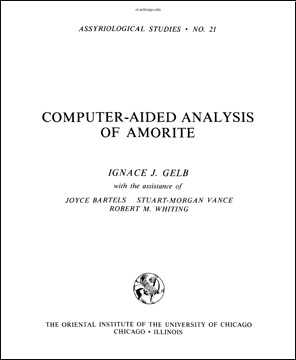AS 21. Computer-aided Analysis of Amorite Ignace J. Gelb, with the assistance of J. Bartls, S.–M. Vance, and R. M. Whiting

Our knowledge of non-Akkadian Semitic dialects that we conventionally call Amorite is based almost exclusively on the analysis of proper names. The bulk of these names appears in cuneiform texts, while about 100 are found in Egyptian inscriptions. The Computer-aided Analysis of Amorite lists 6,662 names excerpted from Sumerian and Akkadian texts dating mainly from the Old Babylonian period. Most names from earlier sources come from Sumerian administrative texts of the Ur III period. No Ebla material is reported. Names from post-Old Babylonian sources, such as Alalakh IV, Ugarit, and Qatna, are adduced only in cases where a point weakly documented in the Old Babylonian times needs bolstering from additional evidence.
When we think that in 1926 Th. Bauer was able to gather about 650 Amorite names, and that H. B. Huffmon’s work based on the Mari material published up to 1963 lists about 900 names, we can better appreciate the tremendous progress realized thanks to I. J. Gelb’s Amorite Computer Project. The author repeatedly stressed that the volume aimed at presenting a large body of source material, ordered in categories that can be utilized in the study of Amorite. [From a review by E. Lipinski in the Journal of Semitic Studies 26 (1981) 277–80]
- Assyriological Studies 21
- Chicago: University of Chicago Press, 1980
- Pp. xv + 657
- Out of Print

